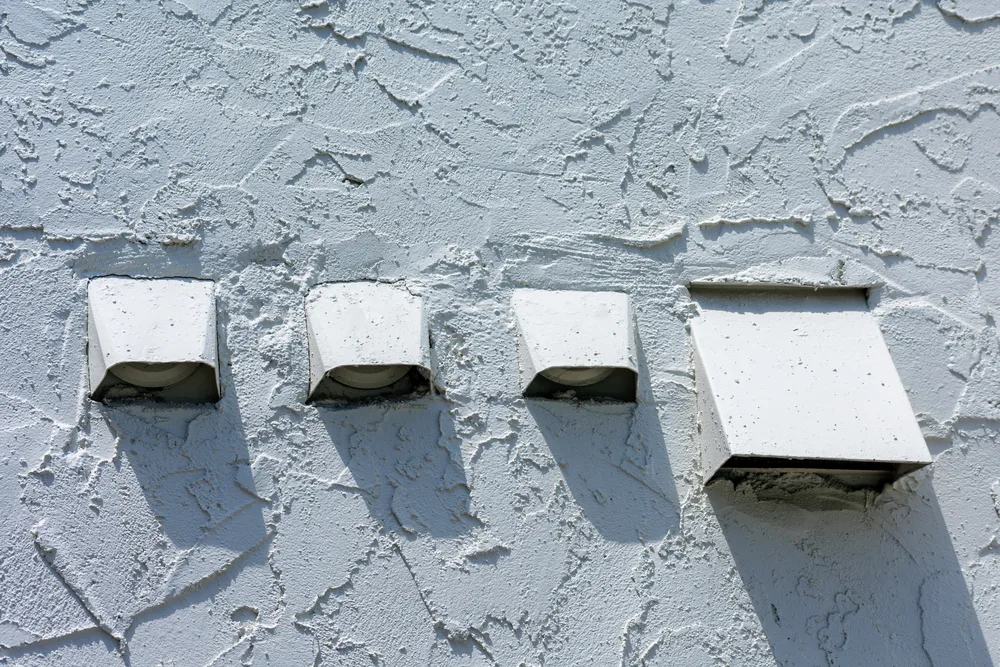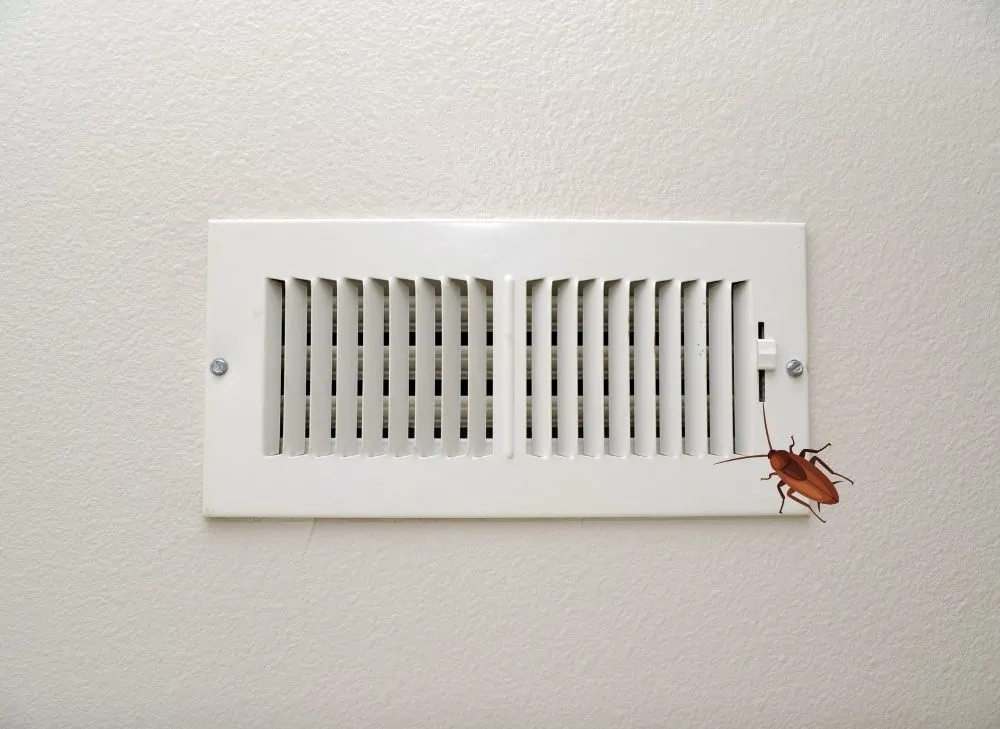Homes and their appliances can be quite noisy, but not all noises are normal and can just be ignored. Not only is it strange and annoying when your dryer vent makes noise when it is off, but the noise could also highlight a problem with your vents that needs to be addressed.
Below, I give a variety of reasons for strange noises in your vents, both mechanical and otherwise. I also provide you with some solutions, which, let’s face it, is why you’ve come here.

Dryer vents make noises if air flows back into them. Exposed vent flaps also bang in the wind. To stop this, repair or replace the damper; clean, repair, or replace the flappers; install vent hoods or weigh the flapper down. Animals in vents make noises. Faulty dryer exhaust fans stay on when the dryer is off.
Backdraft Damper Is Broken
A backdraft damper is an essential part of your dryer’s ventilation—and by essential, I mean that it is mandatory according to the International Residential Code (Section M1502.3).
These devices maintain one-way airflow for your exhaust vent by allowing exhausted air to exit from the vents and preventing outside air from entering your home. It can also prevent pests from making their way in through the dryer vents.
If the backdraft damper is broken, though, one-way airflow is not being maintained and outside air is likely to infiltrate your exhaust vents. This air will move swiftly through the vents, causing a rattling sound similar to when your dryer is running. It can also cause a cold draft and dryer vent leaks.
The damper blades can be damaged or malfunction or the seal may be broken.
How Are Backdraft Dampers Damaged
Backdraft dampers are damaged through natural wear and tear, accelerated wear and tear in situations where it is installed incorrectly or is exposed to harsh elements. Some dampers may even come damaged as a result of a manufacturing flaw.
Another possibility is that animals have caused damage to the damper. As per the IRC (the same section as linked to before), you are not allowed to put a screen on the dryer terminal. This is because lint will build up, reducing the dryer’s efficiency and creating a fire hazard.
When the damper is set a little way back into the vent, then there is room for animals. The air that comes out of a dryer exhaust vent is warm, making the opening by the backdraft damper a comfortable place for insects, especially during the winter. Birds and rodents can try to nest in here.
Nesting in your exhaust vent not only limits the efficiency of the ventilation but animals coming into and out of the backdraft damper can cause your backdraft damper to break.
Solutions
In situations where the blades of the backdraft damper are broken, it is unlikely that they can be repaired. Instead, it is best to replace the damper entirely, especially since most backdraft dampers are less than $20.
The Calimaero Backdraft Damper (amazon link) is a one-size-fits-all, gravity-powered backdraft damper that ensures a long life span and easy installation. The Neverest Professional Backdraft Shutter Damper (amazon link) can withstand extreme temperatures and is essentially rattle-proof.
When choosing the right backdraft damper for your dryer vent, it is important to factor in the compatibility of the backdraft damper.
Not only must the damper fit onto your ventilation, but it must also mitigate lint accumulation. It is very important for your backdraft damper to allow lint to travel through the vent. If most of the lint is trapped by the backdraft damper, this creates a very dangerous fire risk.
If the seal is broken, you may be able to replace it or repair it using heat-resistant caulk.
Flapper Is Stuck Open
Another way to prevent outside air from getting into your dryer vents is through a single-flap vent. These can also produce noise, even when your dryer is off.
The problem is similar to a backdraft damper being broken. A flapper that is stuck open lets in outside air, which infiltrates your dryer vents and can cause noises such as rattling.
A variety of things can cause a flapper to get stuck:
- One is a problem with the hinge of the flap. Sticky hinges often occur due to weathering and wear over time.
- The flapper itself could also be a problem. Due to age or poor-quality material, the shape of the flapper can warp and make it so the flapper cannot close completely.
- Another way a flapper can get stuck open is if there is an obstruction at the mouth of the vent. This obstruction could be an animal nest, a build-up of lint, or dirt and other debris.
Solutions
If the problem is the flapper’s hinge, try cleaning the flap and then spraying a silicone lubricator on the hinge.
Should this fail to stop the noise, or if the flapper is warped, it is wise to replace the vent flap.
The Deflecto Supurr-Vent Louvered Outdoor Dryer Vent Cover (amazon link) is an inexpensive, highly-rated, and durable option. The Calimaero Dryer Vent Cover (amazon link) is made of stainless steel and has a variety of sizes.
When the problem is an obstruction of some kind, you can simply clear the debris from the vent opening.
It is wise to clean your dryer ducts at least once a year to keep them clean and to prevent fires in your household.
Using the correct material for your vents (smooth metal, not foil ducting, PVC, or ABS) will help to control lint build-up.
Mitigating condensation in the duct system can also help you avoid future build-ups in the dryer ducts. Wet surfaces tend to attract lint and other debris and cause them to clump together. If your dryer ducts go through an unconditioned area like a crawlspace and aren’t insulated, this may cause more build-up in your vents.
Vent Terminal Is Too Exposed
If the vent terminal is too exposed, then the wind can open the flapper. This allows wind to gust through the vents but can also pick up and drop the flappers repeatedly, making them bang.

The location and coverage (or lack of coverage) of your vent terminal will determine how likely this is to be the cause of the dyer vent noise.
If your vent terminal juts out with no hood or other coverage from the elements then the vent terminal may be too exposed. This would lead to wind easily infiltrating your dryer ventilation since there isn’t any coverage or shelter from the wind.
The sounds would be similar to the ones that would occur in the first two scenarios. The wind would enter your vents and cause rattling but could also pick up and drop the flappers at your vent terminal, causing even more noise.
Solutions
One solution to protect your terminal from wind is to purchase a hood. Not only will it be more difficult for wind to infiltrate your ventilation system, but your terminal will also be better protected from the elements and from pests.
If you already have a hood and it is not working for you, it may be wise to make some modifications to your flap.
Weighing down your flap can make it harder for the wind to pick it up. Washers or other small weights can do this for you. Make sure the flap isn’t weighed down too much, though. The flap must still be able to open from the movement of air.
The area where the flap hits the vent can also be padded with foam. This is cheap and minimally invasive, and it should dampen sound enough so that you cannot hear the flap moving around with the wind.
Animals/Insects in the Vents
The noises you are hearing in your dryer vents may not be the tapping of a flap, the whooshing of wind, or the rattling of your vents as air flows back into them. Instead, the noises may be distinct scratching or buzzing, meaning you may have an infestation in your dryer vents.

Without a flap vent or a backdraft damper on the exhaust vent, your dryer ventilation system may be in danger of infestation by animals or insects.
Unfortunately, dryer vents are prime real estate for animals and insects since dryer exhaust is often quite warm, which lures cold animals and insects during the cool months of the year. Not only is the air warm, but the vents are also burrow-like and are sheltered from the elements.
Animals and insects in your dryer vents not only make noise but can also impact the functionality of your dryer. A blocked vent can cause a dryer to not work, overheat, and produce a burning smell. The animals may also die and cause your home to smell of rot.
Solutions
In the simplest situation, the animal is a bird and their nest is within reach and can be easily removed without harming them.
The situation may be worse, though, and there could be large rodents living in the vents and making nests out of your reach. They would not be easy to reach or remove and may become aggressive. Hives of bees or wasps would be another dangerous situation.
In these situations, it is wise to call a professional dryer vent technician. If they cannot help with your pest problem, an exterminator may be able to.
To prevent infestations of animals or insects, it is wise to check and clean your dryer vents at least once a year. During this process, signs of nesting can be noticed and promptly removed before the situation becomes worse.
Exhaust Fan Didn’t Turn Off
Your dryer vent has a fan that actively moves air into and through the ducts. Sometimes, these fans can malfunction and stay on or turn on when the dryer is off.
This can be caused by a failed pressure sensor. Positive air pressure from your dryer running is what starts your dryer exhaust fan. If the pressure sensor has malfunctioned in some way, it may not turn itself off when the dryer stops.
Faulty wiring of the pressure sensor, duct leakage, and lint build-up can cause this problem.
Moisture from the dryer can also cause damage to the sensing line. This would impact pressure-sensing and may cause the dryer exhaust fan to not switch off when it is not needed.
Another reason your dryer exhaust fan may be on when it shouldn’t be is if the sensor wasn’t calibrated properly when it was made. As with moisture on the sensor, this would impact pressure-sensing and could cause the dryer exhaust fan to be on when not needed.
Solutions
Depending on the cause, the solutions can vary.
- For leaky ducts impacting the measurement of pressure in your vents, the ducts must be sealed.
- In the case of a wiring problem, a professional should be contacted for safety reasons.
- If the problem is lint build-up in your vents, your vents must be cleaned.
- The sensing line itself may be the problem, so it is wise to inspect it. Cleaning the sensor should aid with a moisture problem. If cleaning the sensor doesn’t work, you may need to replace it.
As one final check before you replace the sensing line, the line has a pressure relief leak through a T-connector on the sensing line. This may cause problems so you can remove this and plug the sensing line into the circuit board. If the sensing line seems fixed, this may have solved the problem.
Sources
http://www.thedryerventguy.net/dryer-vent-repair.html
https://www.familyhandyman.com/project/dryer-vent-cover-repair/
https://thetibble.com/bathroom-fan-noise-windy/
https://www.environmentalchimneyservice.com/can-animals-get-into-my-clothing-dryer-vents/

